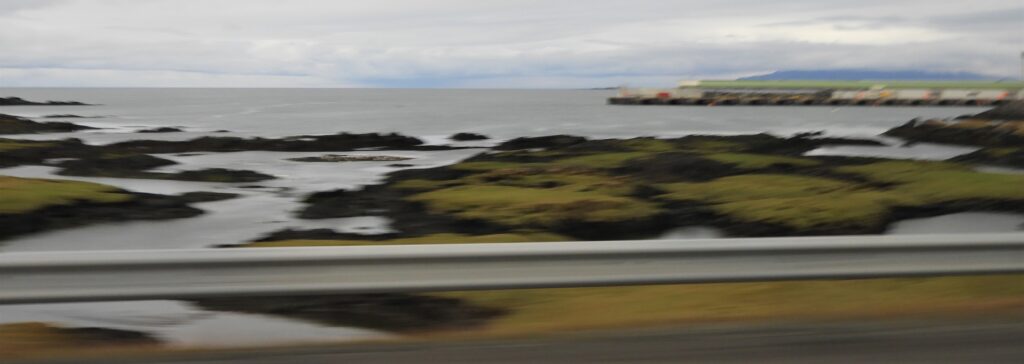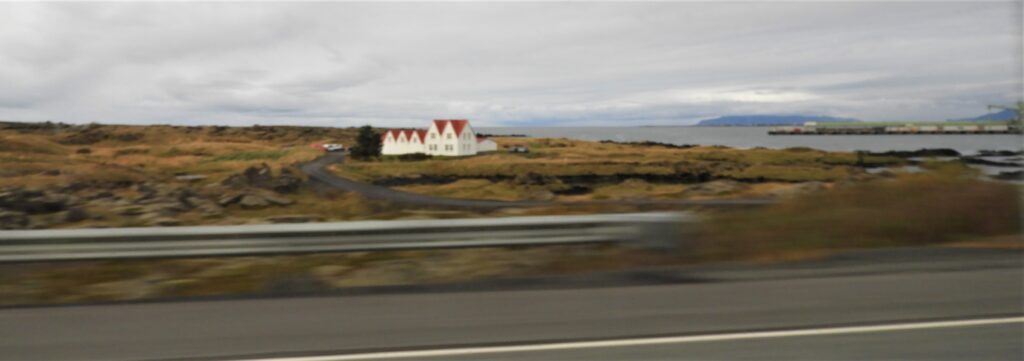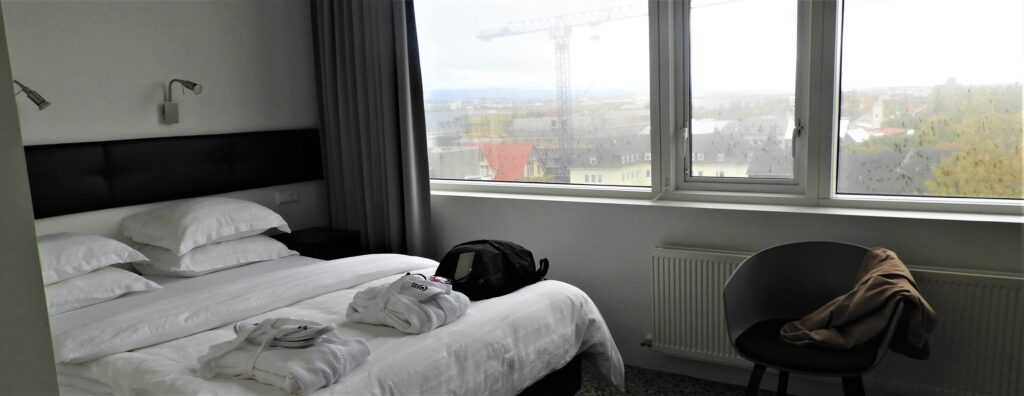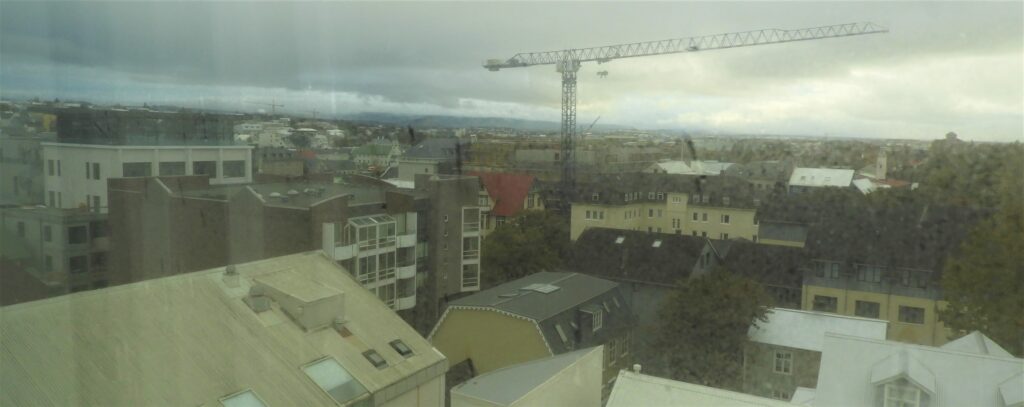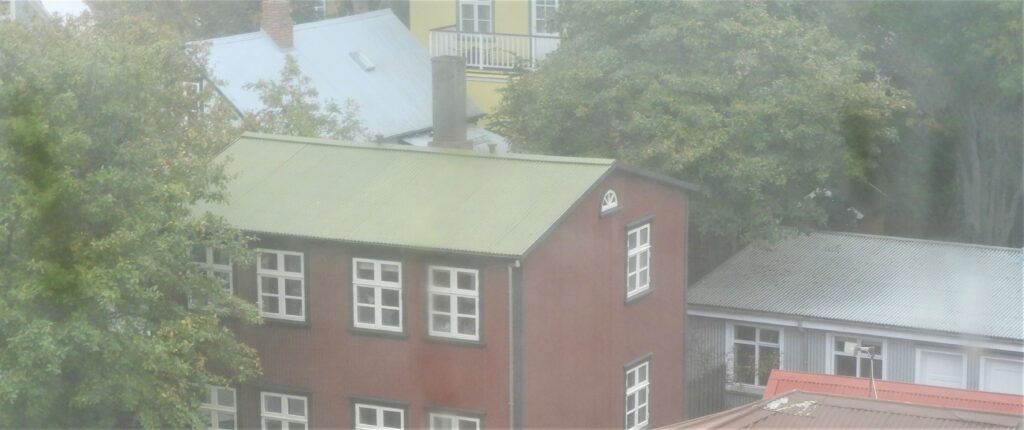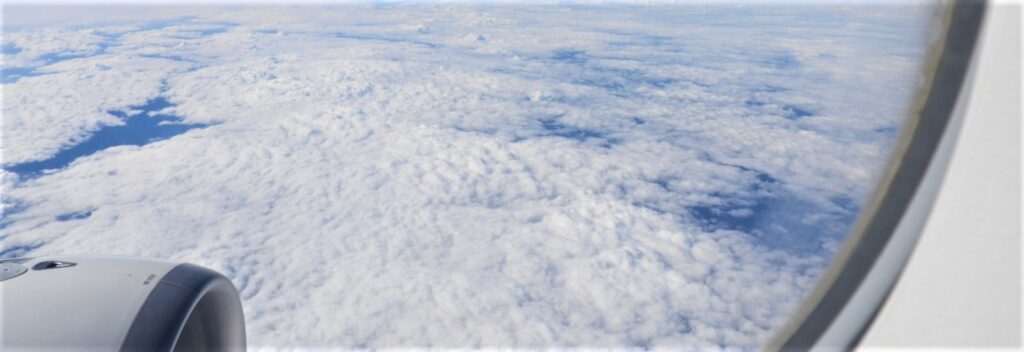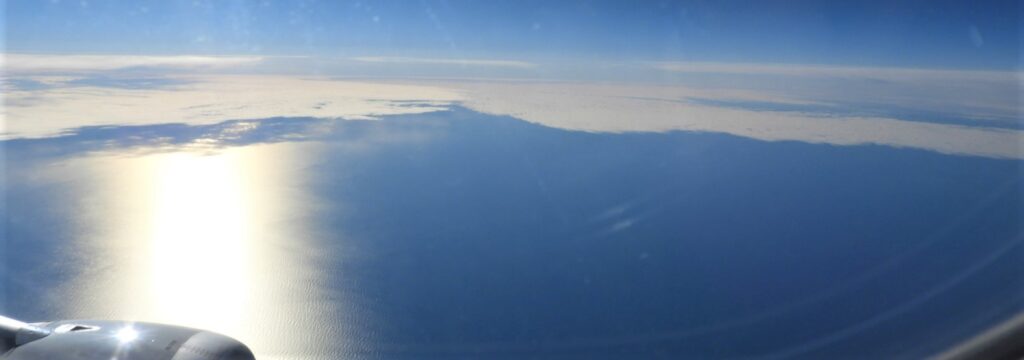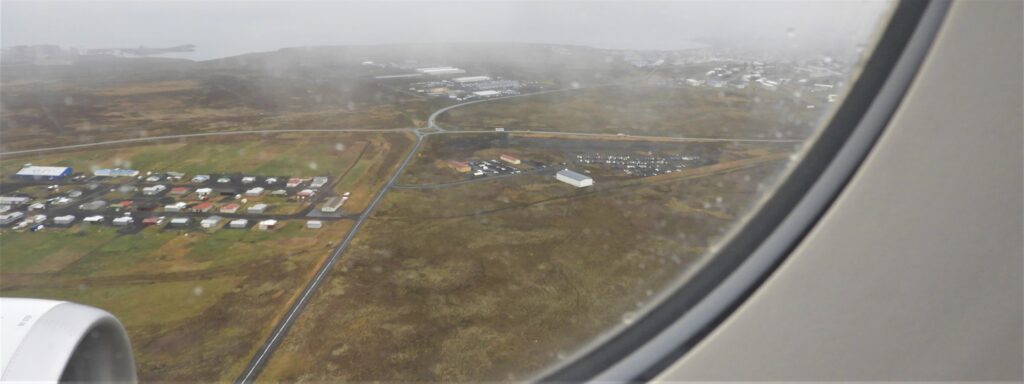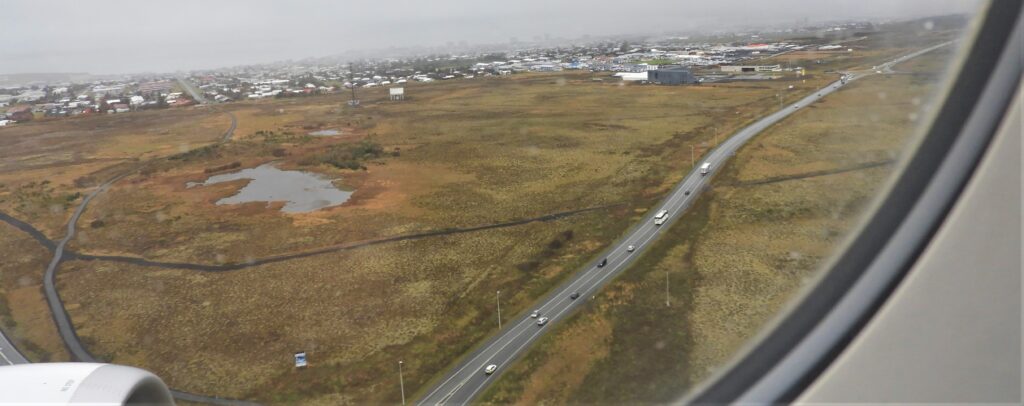Posts Tagged ‘Reykjavik’
» posted on Wednesday, September 28th, 2022 by Linda Lou Burton
Fifty Shades Of Gray
Linda Lou Burton posting from Central Hotels Plaza, Reykjavik, Iceland – Walter was his name. Walter welcomed us to Iceland. Actually, a young woman welcomed us first with the wheelchair, whisking us rapidly down to luggage. We’d checked our bags in Zanzibar, and luck was with us, they followed all the way to the Arctic Circle. She whisked us past Joe the cat, and his wise take on life – When nothing goes right…go left. – but no 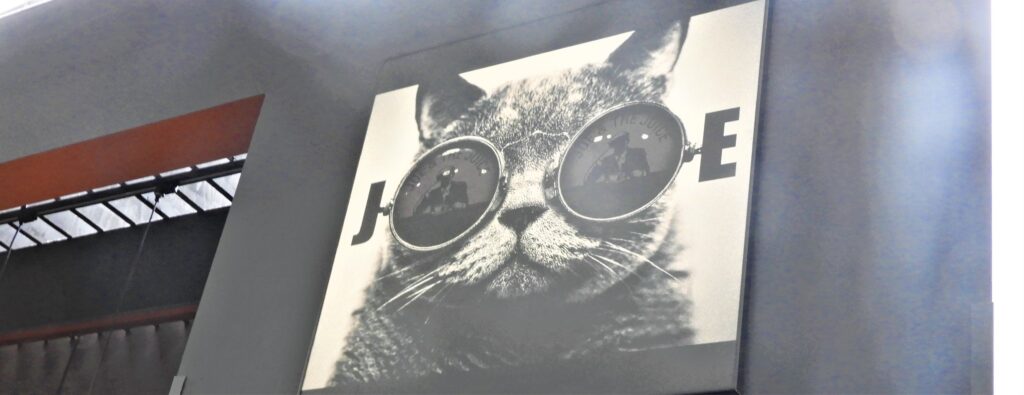
 stopping for juice. She whisked us to the front of the terminal and said “Here you are.” Taxis were rowed a distance away, but I didn’t see the Reykjavik shuttle bus I’d read about. So I asked. “Yes, there is a bus,” she explained. “It goes to a terminal downtown, then you get a taxi to your hotel. Or walk. Or you can get a taxi from here.” I looked at Rick, hmmm, taxi now or taxi later? We decided on taxi now. Walter opened the doors to his rather large, luxurious van but didn’t speak. Walter drove us to Reykjavik, 31 miles on Highway 41, alongside gray waters that were part of the Atlantic Ocean. Or was it called the Sea of Greenland right there? Greenland was off in that direction. It was gray. The skies were gray. The pavement was gray.
stopping for juice. She whisked us to the front of the terminal and said “Here you are.” Taxis were rowed a distance away, but I didn’t see the Reykjavik shuttle bus I’d read about. So I asked. “Yes, there is a bus,” she explained. “It goes to a terminal downtown, then you get a taxi to your hotel. Or walk. Or you can get a taxi from here.” I looked at Rick, hmmm, taxi now or taxi later? We decided on taxi now. Walter opened the doors to his rather large, luxurious van but didn’t speak. Walter drove us to Reykjavik, 31 miles on Highway 41, alongside gray waters that were part of the Atlantic Ocean. Or was it called the Sea of Greenland right there? Greenland was off in that direction. It was gray. The skies were gray. The pavement was gray.
And Walter seemed rather gray. He didn’t talk, at all. When we arrived at our hotel, he turned to look at us, credit card reader in hand. I handed him my card. He handed me a receipt. “I can take you back to the airport if you want to make an appointment,” he said, handing me his card. “I’ll let you know,” I replied. Walter set our bags on the sidewalk and drove away. It wasn’t just chilly, it was windy cold. It was gray. We jiggered our bags across the wet street; into the hotel, front desk. Our rooms were ready. That way. We jiggered our bags across the lobby, up the elevator. Two rooms. Peace and quiet. Black and white. Gray. The walls were gray. My window was foggy gray. I looked across the rooftops to the gray clouds beyond. 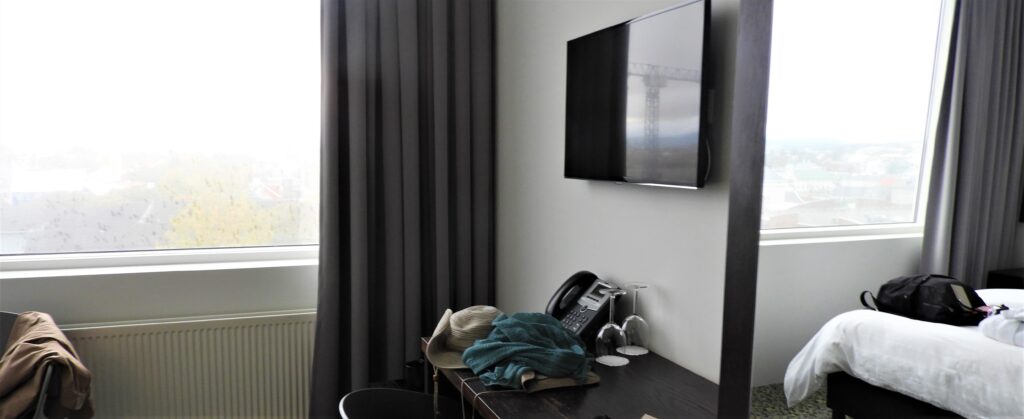
How do I know his name was Walter? It was printed on his card. So this is Iceland, huh?
Center Hotels Plaza, Reykjavik, Iceland https://www.centerhotels.com/en/hotel-plaza-reykjavik
Keflavik Airport, Reykjavik, Iceland https://www.isavia.is/en/keflavik-airport
Next Post: But Then,
» posted on Wednesday, September 28th, 2022 by Linda Lou Burton
Goldfish For Lunch
Linda Lou Burton posting from Flight # LX8300, Edelweiss Airlines, Keflavik Airport, Iceland – Got your calculator? Here’s a math problem for you. If you leave Zanzibar at 10:30 PM Tuesday and land in Zurich at 6:10 AM Wednesday; then leave Zurich at 1 PM and arrive in Iceland at 2:55 PM; and you change time zones by 3 hours overall, what time do you eat lunch? The entire issue becomes irrelevant I suppose, when you fly Edelweiss. Because they give you Goldfish to munch on any time you please! I grabbed a handful of Goldfish bags the minute they were offered and stacked them greedily in my lap.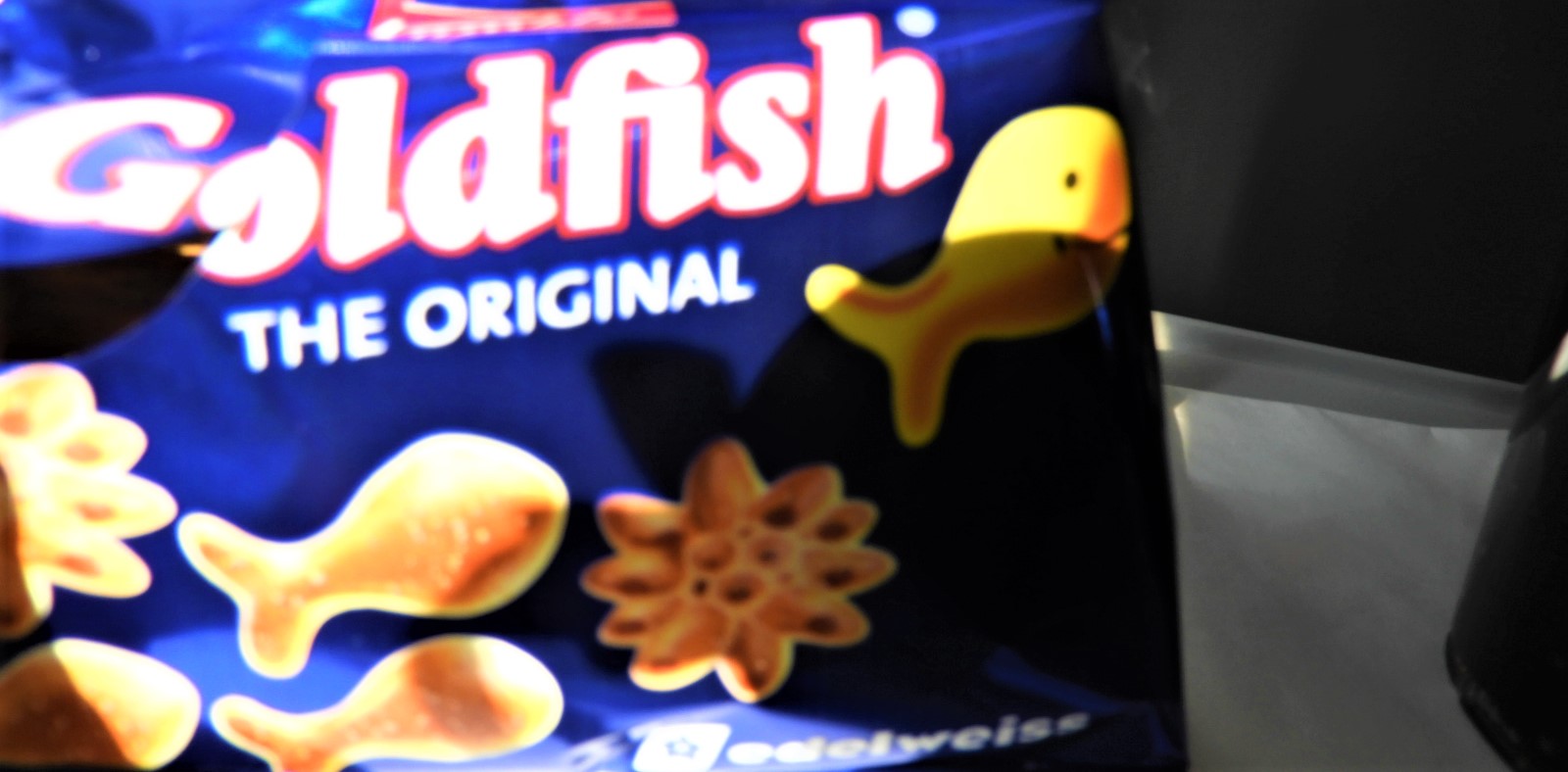
I was living in high country now; our seat row was just behind the curtain separating us from business class (a step up for sure, at least we’re breathing the same air!); I had adequate foot room, and I had a window seat! The flight time from Zurich to Reykjavik’s International Airport was under four hours, so much less daunting that the “getting into Africa” adventures had been. Rick and I both were excited, not quite sure how the climate change was going to hit us. And, for the first time, we were totally on our own. No Globus guides running interference for us or drivers aiming to honor all our whims and preferences. “Flying solo and eating Goldfish,” I laughed to Rick, looking out my window, hoping to see an Alp or two.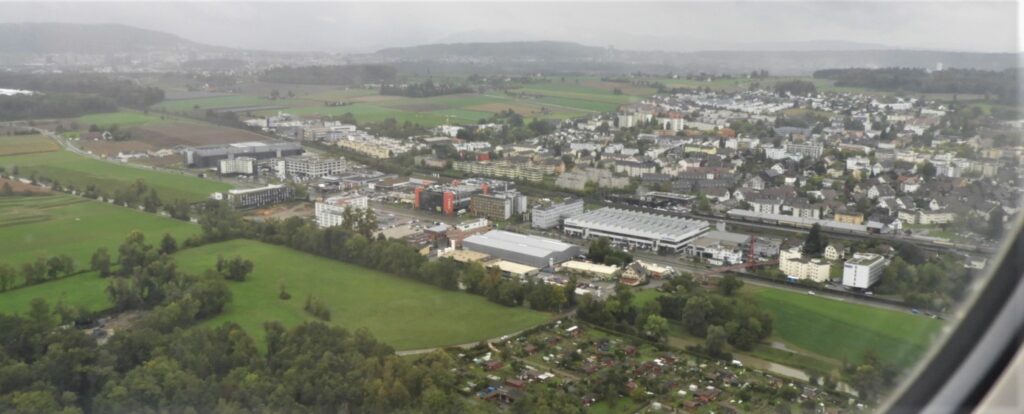
All I saw was green, the brilliant, well-tended green of well-watered farmland; houses neatly rowed in villages. No elephants, no zebras, no giraffes. We flew over the edges of Germany and France; we flew above Belgium, the Netherlands, Scotland. The North Sea. The Atlantic.
Now we’re in Icelandic territory (it’s part of Europe but you can’t get there by car!); the landscape has an unfamiliar look. The ground is a different shade of green; the houses lower; the skies grayer. There’s the airport. The attendant has collected all my empty Goldfish bags so I’m done eating now, and I can give you a surprising factoid about Reykjavik’s International Airport – Keflavik. It was built by the US military during WWII!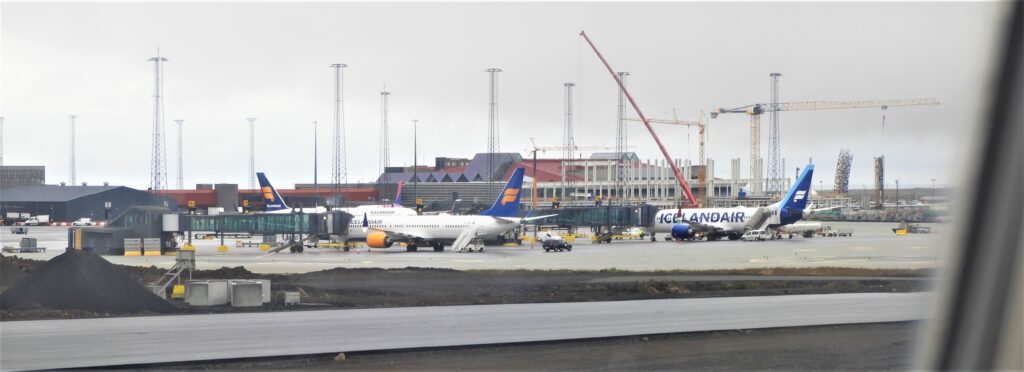
Think about that, and Iceland’s role during the war. Meanwhile, Rick and I will be hunting for a way to get to our hotel. Jackets on.
Zurich Airport https://www.flughafen-zuerich.ch/en/passengers
Keflavik Airport, Reykjavik, Iceland https://www.isavia.is/en/keflavik-airport
Next Post: Fifty Shades of Gray
» posted on Wednesday, August 31st, 2022 by Linda Lou Burton
About Iceland
Linda Lou Burton posting from Little Rock, Arkansas – I know you’re wondering – why on earth would anyone go almost to the Arctic Circle after journeying to the Equator? There’s a good story behind it, which I’ll save for later. But top reason to go to Iceland is much the same reason for going to Africa: I’ve wanted to for a very, very long time. And since you have to go through Europe to get back to the US from Africa, what’s a few hours more flying time to hop a bit further north? Here are some things you need to know.
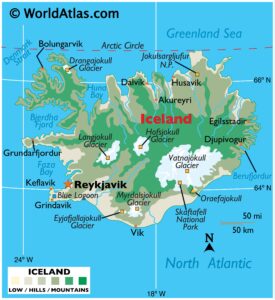 How big is Iceland? Where is it? What does it look like?
How big is Iceland? Where is it? What does it look like?
Iceland is about the size of the US state of Virginia. Technically a part of Europe, it is perched in the North Atlantic between Norway and Greenland, just brushing the Arctic Circle. It is the biggest part of the Mid-Atlantic Ridge that rises above sea level, and its central volcanic plateau erupts frequently. The interior consists of a plateau of sand and lava fields, mountains, and glaciers. Many rivers flow to the sea through the lowlands. Altogether a striking landscape of breathtaking waterfalls, bubbling geothermals, and rugged coastline.
How about Iceland’s weather?
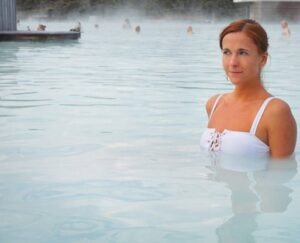 With a name that speaks of ICE, and a location not that far from the North Pole, Iceland has a surprisingly temperate climate. The Gulf Stream gets credit for that, plus the fact that Iceland sits atop a massive magma hot spot called the Iceland Plume. Outdoor swimming goes on year-round thanks to geothermal pools; houses are heated that way as well. Still, expect frequent weather changes in a day’s time; layer up. Last-day-of-August highs and lows: Little Rock 90-73; Reykjavik 53-44.
With a name that speaks of ICE, and a location not that far from the North Pole, Iceland has a surprisingly temperate climate. The Gulf Stream gets credit for that, plus the fact that Iceland sits atop a massive magma hot spot called the Iceland Plume. Outdoor swimming goes on year-round thanks to geothermal pools; houses are heated that way as well. Still, expect frequent weather changes in a day’s time; layer up. Last-day-of-August highs and lows: Little Rock 90-73; Reykjavik 53-44.
Who lives in Iceland?
Iceland’s people population last year was estimated at 376,248; 89% of that is of Icelandic heritage. Most Icelanders are descendants of Norse and Gaelic settlers. Icelandic, a North Germanic language, is descended from Old West Norse. Rather than using family names, as is the custom in most Western nations, Icelanders carry patronymic or matronymic surnames, and refer to one another by their given name. Patronymic last names are based on the first name of the father; matronymic names on the first name of the mother. These follow the person’s given name, e.g. Elísabet Jónsdóttir (“Elísabet, Jón’s daughter, ” Jón, being the father), or Ólafur Katrínarson (“Ólafur, Katrín’s son,” Katrín being the mother). 
As to the animal population, before humans settled in the 9th century, Iceland had only one land mammal, the Arctic fox. The rest of the creatures were either birds or marine animals. A millennium later, a wealth of life has adapted to the harsh climate, one of the most unique being the sturdy Icelandic horse, its bloodline so protected no imported horses are allowed. Sheep roam freely, reindeer too, but it’s the marine life that tops the list – whales, seals, dolphins, and 340 species of fish.
How does Iceland promote itself on its Visit Iceland site?
The coolest thing to see in Iceland today is a hot volcano. The Fagradalsfjall Volcano system awoke again on August 3, 2022, and is calm enough to sit close by and watch it spew and glow. Or you can go whale watching, berry picking, ice-cave exploring or simply sit on a tour bus and be driven from point to glorious point. Downtown Reykjavik is a walker’s paradise, plazas and parks and hop-on/hop-off buses. There are 266 museums in Iceland, 130 volcanoes, and an impressive array of restaurants. Seafood anyone?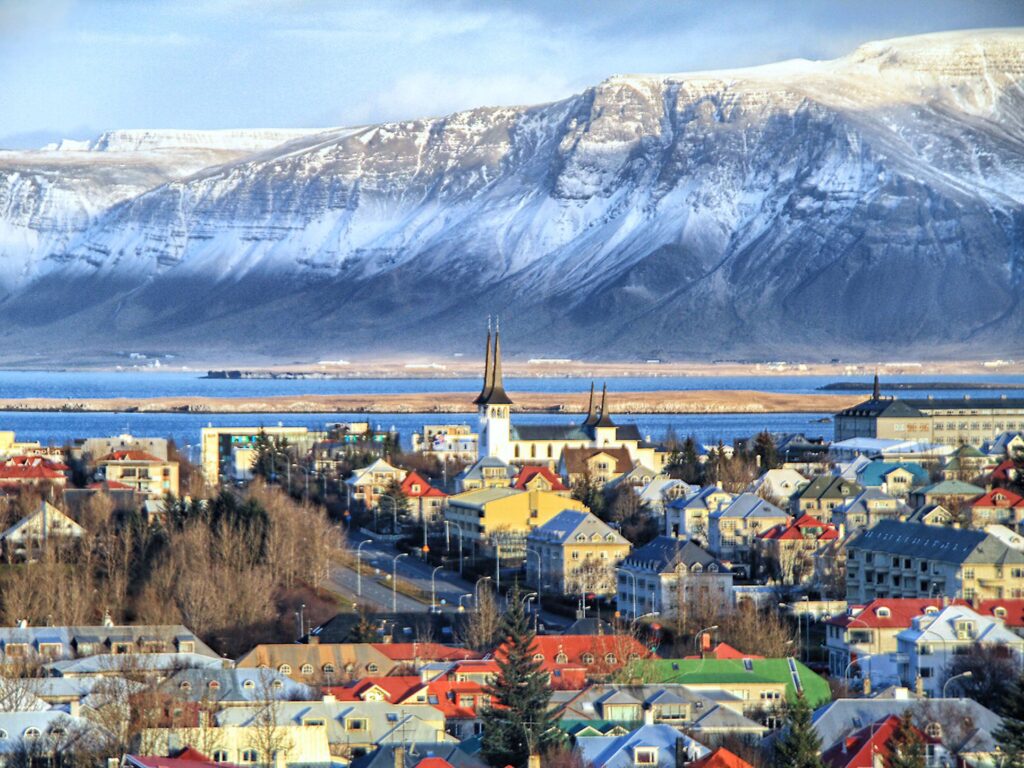
» posted on Friday, August 19th, 2022 by Linda Lou Burton
Extremely Satisfied
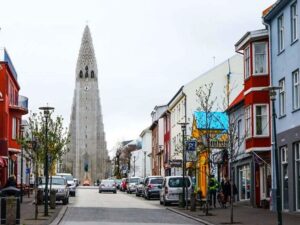 Originally published August 13, 2020 by Linda Lou Burton posting about Reykjavik, Iceland from Little Rock, Arkansas – We did it! We actually did everything on the list that each of us wanted to do. Extremely satisfied. And now we’re on the plane, headed for Washington DC. I’ve got to sum it up, for history’s sake. Yesterday I rented a car; hey, steering wheel on the left, driving on the right, small town. The GPS gave me English, so getting around was a breeze. Drove 3 miles along the waterfront to breakfast, here’s how Wednesday went.
Originally published August 13, 2020 by Linda Lou Burton posting about Reykjavik, Iceland from Little Rock, Arkansas – We did it! We actually did everything on the list that each of us wanted to do. Extremely satisfied. And now we’re on the plane, headed for Washington DC. I’ve got to sum it up, for history’s sake. Yesterday I rented a car; hey, steering wheel on the left, driving on the right, small town. The GPS gave me English, so getting around was a breeze. Drove 3 miles along the waterfront to breakfast, here’s how Wednesday went.
- Kaffivagninn for breakfast; we called it the Kaff. Friendly place, boats to watch, birds; everybody ate eggs in some form, I loved the coffee. Note: Icelanders drink a lot of coffee, also a lot of Coke, the highest per capita consumption in the world! https://kaffivagninn.is/en/
 Saga Museum next, it was right at the corner where we turned. It’s the VIKING Saga Museum, legends from the Icelandic sagas in 17 exhibits, wax historical figures like Leifur Eiriksson; an audio device to hang around your neck, select your language and go. At the end you can dress in Viking clothes and take pictures of yourself looking fierce. We did, it was interesting, and fun. https://www.sagamuseum.is/
Saga Museum next, it was right at the corner where we turned. It’s the VIKING Saga Museum, legends from the Icelandic sagas in 17 exhibits, wax historical figures like Leifur Eiriksson; an audio device to hang around your neck, select your language and go. At the end you can dress in Viking clothes and take pictures of yourself looking fierce. We did, it was interesting, and fun. https://www.sagamuseum.is/- Old Harbor Souvenirs for souvenirs; Whale Watching boats galore; a little walking on the Sculpture and Shore Walk, so pretty, and there we were at the famous Penis Museum. Of course we went in.
- Icelandic Phallological Museum, the only museum in the world containing phallic specimens from all types of mammal found in a single country; 17 different kinds of whale, 7 different kinds of seal and walrus, and 20 different kinds of land mammal; in all, 209 specimens including Homo Sapiens. There are even 24 folklore specimens! Well organized museum; awards from Trip Advisor and others. https://phallus.is/en/
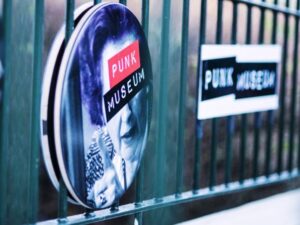 Icelandic Punk Museum was just a few blocks away. Another unique; NOT organized is part of its charm; it was once a public toilet; exhibits are in the former toilets and washbasins; photos, posters, instruments, streaming videos; the story of Icelandic punk. Pull-down headphones for listening to records; jackets to pose in with guitars and drums. Johnny Rotten was here for its opening in 2016. https://m.facebook.com/Bankastraeti0/
Icelandic Punk Museum was just a few blocks away. Another unique; NOT organized is part of its charm; it was once a public toilet; exhibits are in the former toilets and washbasins; photos, posters, instruments, streaming videos; the story of Icelandic punk. Pull-down headphones for listening to records; jackets to pose in with guitars and drums. Johnny Rotten was here for its opening in 2016. https://m.facebook.com/Bankastraeti0/
From Leif Erikson to Johhny Rotten in four miles! Time for a lunch break. “Well,” we agreed, still sort of dizzy, “we’re not likely to see any of that anywhere else.” That’s the “Guide to Good Sightseeing” rule. Nowhere else in the world. On to the food court.
- Hlemmur Food Hall was busy, and we scattered to make our choices. One went for pizza at Flatey, two went to Skal for small plates, like vegan, and codcakes. Flatey’s wins Best Pizza awards year after year; everybody that ever eats at Skals agrees the food there is “to die for.” Everybody happy. Next? Harpa Tours happen only at 2 PM. We admired the Concert Hall from the outside earlier, now we want to see how it was built. On to Harpa. http://www.hlemmurmatholl.is/english
 Harpa Concert Hall is home to the Symphony & Opera, it seats 1,800 and is 300,000 sq ft and 141 feet tall, an architectural masterpiece with an amazing glass façade. Its unique design was inspired by Icelandic forces of nature and the northern lights; tours go to places only performers get to see; learn about how it was built, the acoustics, the technology, and some of the great performances that have taken place here. Great photo ops, awesome. Underground, next. https://en.harpa.is/
Harpa Concert Hall is home to the Symphony & Opera, it seats 1,800 and is 300,000 sq ft and 141 feet tall, an architectural masterpiece with an amazing glass façade. Its unique design was inspired by Icelandic forces of nature and the northern lights; tours go to places only performers get to see; learn about how it was built, the acoustics, the technology, and some of the great performances that have taken place here. Great photo ops, awesome. Underground, next. https://en.harpa.is/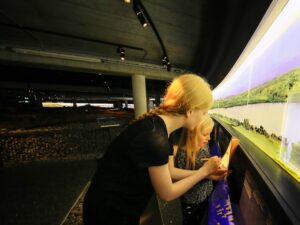 Settlement Exhibition is an archaeological open excavation-museum; just below ground in downtown Reykjavík. Discovered during building work in 2001, the remains are the earliest evidence of human settlement here, with some dating to before AD 871±2. A 10th century longhouse is the focal point; the museum combines technology and archaeology with interactive multimedia tables explaining the excavations; a space-age panel allows you to steer through different layers of the longhouse construction. Very cool. https://reykjavikcitymuseum.is/the-settlement-exhibition
Settlement Exhibition is an archaeological open excavation-museum; just below ground in downtown Reykjavík. Discovered during building work in 2001, the remains are the earliest evidence of human settlement here, with some dating to before AD 871±2. A 10th century longhouse is the focal point; the museum combines technology and archaeology with interactive multimedia tables explaining the excavations; a space-age panel allows you to steer through different layers of the longhouse construction. Very cool. https://reykjavikcitymuseum.is/the-settlement-exhibition- National Museum of Iceland covers Iceland’s history; the Settlement Era – including the rule of the chieftans and the introduction of Christianity –features swords, drinking horns, silver hoards, and a powerful bronze figure of Thor. The priceless 13th-century Valþjófsstaðir church door is carved with the story of a knight, his faithful lion and a passel of dragons. Modern-age displays too, and a smartphone audio guide to explain it all. A perfect fit after the archeology, but we are beat. To the hotel to rest and spruce up a bit before the One and Only Last Night’s Dinner at Grillmarket. https://www.thjodminjasafn.is/english/
 Grillmarket reservation, 8 PM, they offer a Tasting Menu, chef’s selections served family style; and a Trip to the Countryside, with three of the most popular starters and then beef steak with fries and vegetables for everyone; then a taste of each of the desserts. TEMPTING, but our independent natures decided we’re rather ponder our choices. And we did, each to his own, oh my, delicious. https://www.grillmarkadurinn.is/en/
Grillmarket reservation, 8 PM, they offer a Tasting Menu, chef’s selections served family style; and a Trip to the Countryside, with three of the most popular starters and then beef steak with fries and vegetables for everyone; then a taste of each of the desserts. TEMPTING, but our independent natures decided we’re rather ponder our choices. And we did, each to his own, oh my, delicious. https://www.grillmarkadurinn.is/en/
Thursday. A really good night sleep, the final desserts last night made sure of that. The sun came up at 5:14 this morning but we didn’t see it; we were still snoozing and it was raining. A lazy breakfast at the hotel in our picture-window breakfast lounge; pack the bags, load the car, and head for Perlan, and then the Blue Lagoon. Did we save the Best for Last?
Perlan
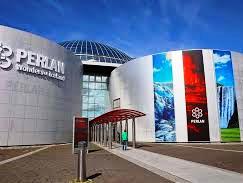 Perlan, or The Pearl is Reykjavik’s # 1 attraction as a a Must-Visit Landmark. Now a “Nature Exploratorium” with a revolving glassdomed restaurant and observation deck, it sits in a forest atop Öskjuhlíð hill overlooking the city. We get tickets for everything; Wonders of Iceland & Áróra – Northern Lights Planetarium Show; the Wonders of Iceland exhibit shows Icelandic nature, glaciers, geysers, and volcanoes. There is also a timeline explaining how Iceland was formed and how life in Iceland evolved. We definitely want the Planetarium Show about Icelandic nature and the solar system. Perlan was opened to the public in 1991. The building is a story in itself; composed of an immense glass dome that sits on six hot-water tanks, each carrying 4 million litres of geothermal hot water. All of this is supported by a colossal steel frame, which serves important functions in addition to holding everything together. The framework, hollow on the inside, is actually a gigantic radiator. In the winter when it is cold, hot water runs through the frame, while cold water is used in the summertime. Of course we have lunch in the revolving restaurant, chewing slowly to be sure we make the full turn. And then a 40-minute drive to the Blue Lagoon. https://perlan.is/?lang=en
Perlan, or The Pearl is Reykjavik’s # 1 attraction as a a Must-Visit Landmark. Now a “Nature Exploratorium” with a revolving glassdomed restaurant and observation deck, it sits in a forest atop Öskjuhlíð hill overlooking the city. We get tickets for everything; Wonders of Iceland & Áróra – Northern Lights Planetarium Show; the Wonders of Iceland exhibit shows Icelandic nature, glaciers, geysers, and volcanoes. There is also a timeline explaining how Iceland was formed and how life in Iceland evolved. We definitely want the Planetarium Show about Icelandic nature and the solar system. Perlan was opened to the public in 1991. The building is a story in itself; composed of an immense glass dome that sits on six hot-water tanks, each carrying 4 million litres of geothermal hot water. All of this is supported by a colossal steel frame, which serves important functions in addition to holding everything together. The framework, hollow on the inside, is actually a gigantic radiator. In the winter when it is cold, hot water runs through the frame, while cold water is used in the summertime. Of course we have lunch in the revolving restaurant, chewing slowly to be sure we make the full turn. And then a 40-minute drive to the Blue Lagoon. https://perlan.is/?lang=en
Blue Lagoon
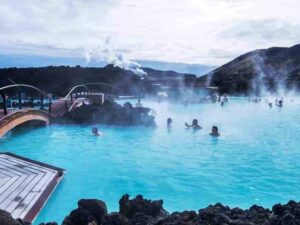 The Blue Lagoon is a geothermal spa in a lava field. It is a top attraction in Iceland too, nearly a million people a year wade and swim in its milky-blue mineral-rich 102-degrees waters. The lagoon is manmade; the water is a byproduct from the nearby geothermal power plant Svartsengi where superheated water is vented from the ground near a lava flow and used to run turbines that generate electricity. After going through the turbines, the steam and hot water passes through a heat exchanger to provide heat for a municipal water heating system. Then the water is fed into the lagoon. The water completely renews itself every 48 hours; the average pH is 7.5 and the salt content is 2.5%. Despite not being artificially disinfected, the water contains no bacteria, fungi, or plants. The Comfort Ticket covers our entrance fee, a silica mud mask at the mask bar, a towel, and a free drink. A Premium Ticket includes a bathrobe and lunch, but we are happy just floating in the warm waters enjoying the scenery. It IS otherworldly, as advertised, steam rising on this chilly day. What a relaxing place, after yesterday’s rush, but alas, we had a plane to catch. https://www.bluelagoon.com/
The Blue Lagoon is a geothermal spa in a lava field. It is a top attraction in Iceland too, nearly a million people a year wade and swim in its milky-blue mineral-rich 102-degrees waters. The lagoon is manmade; the water is a byproduct from the nearby geothermal power plant Svartsengi where superheated water is vented from the ground near a lava flow and used to run turbines that generate electricity. After going through the turbines, the steam and hot water passes through a heat exchanger to provide heat for a municipal water heating system. Then the water is fed into the lagoon. The water completely renews itself every 48 hours; the average pH is 7.5 and the salt content is 2.5%. Despite not being artificially disinfected, the water contains no bacteria, fungi, or plants. The Comfort Ticket covers our entrance fee, a silica mud mask at the mask bar, a towel, and a free drink. A Premium Ticket includes a bathrobe and lunch, but we are happy just floating in the warm waters enjoying the scenery. It IS otherworldly, as advertised, steam rising on this chilly day. What a relaxing place, after yesterday’s rush, but alas, we had a plane to catch. https://www.bluelagoon.com/
Keflavik International was just 20 minutes away. Our Iceland Air flight to Washington DC departed at 4:50 and lands at Dulles at 7:10 EDT. The sun sets at 8:04, just about the time we get to the Hyatt Place on New York Avenue; it is raining there too, and hot. I’ll be back on US soil for the first time in 26 days. That’s a good thing. But Iceland was truly the icing on the cake of my NDI RTW.
It’s hard to leave a country of such good natured, fun loving, happy people that it leads the world in the “I’m extremely satisfied with my life” factor!
» posted on Thursday, August 18th, 2022 by Linda Lou Burton
Morgunmatur, Hádegismatur, & Kvöldmatur
Originally published August 12, 2020 by Linda Lou Burton posting about Reykjavik, Iceland from Little Rock, Arkansas – Food is one of the “most telling” measures of a country and its people. Nowadays food is shipped from 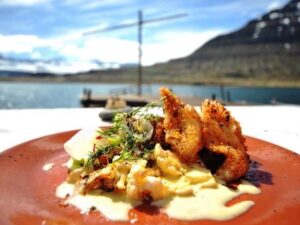 continent to continent in a day; but food traditions handed down over time remain favored – steak and potatoes, or fava beans, or strictly fresh-caught fish. So today, what can we learn about Iceland from simply EATING? That means not only the food and its preparation, but the people we rub elbows with; the locals. I wanted us to have three entirely different food experiences today, while being comfortable within our own “food finickies” at the same time. What is the OLDEST restaurant in Reykjavik was my first question. If it has been around before “tourism” took hold, the locals must like it. The answer turned out to be a pretty good start for the day, with breakfast.
continent to continent in a day; but food traditions handed down over time remain favored – steak and potatoes, or fava beans, or strictly fresh-caught fish. So today, what can we learn about Iceland from simply EATING? That means not only the food and its preparation, but the people we rub elbows with; the locals. I wanted us to have three entirely different food experiences today, while being comfortable within our own “food finickies” at the same time. What is the OLDEST restaurant in Reykjavik was my first question. If it has been around before “tourism” took hold, the locals must like it. The answer turned out to be a pretty good start for the day, with breakfast.
Morgunmatur, aka Breakfast
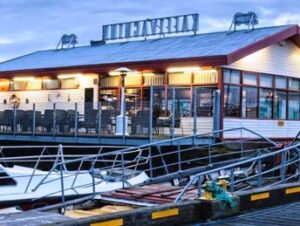 Kaffivagninn is the oldest operating restaurant in Iceland, serving breakfast, lunch, and dinner 7 days a week. This restaurant started as a food truck in 1935; by the 50s it was a small building on wheels, big enough for 10 to 15 people and located right by the harbor. It was very popular with fishermen, opening early and closing late. In the early 60s the restaurant expanded in size; it soon became popular with students and truck drivers as well as fishermen. Since 1975 Kaffivagninn has looked about the same. Right there by the water, plain and simple, and enduring. A great (historic) way to start our day and a menu that will please the three of us. https://kaffivagninn.is/en/
Kaffivagninn is the oldest operating restaurant in Iceland, serving breakfast, lunch, and dinner 7 days a week. This restaurant started as a food truck in 1935; by the 50s it was a small building on wheels, big enough for 10 to 15 people and located right by the harbor. It was very popular with fishermen, opening early and closing late. In the early 60s the restaurant expanded in size; it soon became popular with students and truck drivers as well as fishermen. Since 1975 Kaffivagninn has looked about the same. Right there by the water, plain and simple, and enduring. A great (historic) way to start our day and a menu that will please the three of us. https://kaffivagninn.is/en/
BREAKFAST SERVED FROM 7:30 AM TO 11:00 AM
- BACON AND EGGS with toast and vegetables
- DELUXE OATMEAL PORRIDGE with chia, apples, dates and berries
- GRILLED SANDWICH with ham and cheese, add a fried egg
- OMELETTE with toast and 2 toppings, ham, cheese, mushrooms, peppers, onions or tomatoes
- SMOKED ICELANDIC SALMON with scrambled eggs, toast and vegetables
- TUNA MELT on toasted sunflower seed bread with grilled cheese, with Dijon, apples, salad and jalapeño
Energy enough after breakfast to tackle at least three small museums in the Old Harbor area; time to watch the boats moving in and out of the harbor; time to watch for puffins, and listen to the sounds of the three languages taught in Iceland’s schools – Icelandic, English, and Danish, before getting hungry again, and ready for lunch. A FOOD COURT is one of the best ways I know to make sure each of the three of us are happy with the foods, and to mingle with the locals on their lunchtime break from work. Reykjavik has several food courts; I chose Hlemmur, with 10 vendors and this promo ALL KINDS OF FOOD, FOR ALL KINDS OF PEOPLE.
Hádegismatur, aka Lunch
 Hlemmur Food Hall is the first of its kind in Reykjavik and is inspired by the great European food halls. It attracts a fun crowd especially during lunchtime, when it is booming with customers. On sunny days, people enjoy their food and beverages outside. With Neapolitan pizza, LA-style tacos, Danish sandwiches, fresh soups, Vietnamese cuisine, gourmet burgers, and specialties from the “2019 Michelin Bib Gourmand-awarded Skál,” there’s something for everybody! Open from 8 AM to 9 PM daily. http://www.hlemmurmatholl.is/english
Hlemmur Food Hall is the first of its kind in Reykjavik and is inspired by the great European food halls. It attracts a fun crowd especially during lunchtime, when it is booming with customers. On sunny days, people enjoy their food and beverages outside. With Neapolitan pizza, LA-style tacos, Danish sandwiches, fresh soups, Vietnamese cuisine, gourmet burgers, and specialties from the “2019 Michelin Bib Gourmand-awarded Skál,” there’s something for everybody! Open from 8 AM to 9 PM daily. http://www.hlemmurmatholl.is/english
- BÁNH MÍ Vietnamese coffee and bánh mí sandwiches; crisp pickles, savoury meats, sriracha, and fresh aromatics; Davíð Viet Quoc’s secret family recipes passed down through generations.
- Brauð & Co (Bread & Co); organic sourdough bread and buttery danishes; observe the bakers at work; ask about ingredients, methods, or the weather, every Icelander’s favorite subject!
- FLATEY PIZZA Short delivery time, simple quality ingredients and delicate craftsmanship is the trademark; the outcome is naturally tasty and health conscious pizzas.
- FUEGO L.A. style Tacos in Hlemmur Foodhall. Legendary fish tacos!
- Kröst specializes in fine French wines, cured meats, and various grilled delicacies.
- Micro Roast Te & Kaffi; all things coffee-related; a range desserts and snacks. Their fair trade coffee is shipped daily from their roaster at Aðalstræti only a few blocks away.
- OSTERIA EMILIANA; an Italian restaurant inspired by Emelianan-Romagna region; specializes in real Lasagna and Focaccia bread.
- SKÁL!; an experimental bar & restaurant with a focus on foraged Icelandic ingredients and local traditions.
- TIL SJÁVAR & TIL SVEITA Traditional Icelandic food from the land and sea. Something delicious for the whole family.
Okay, that was fun. Are we in the mood for more museums? A nap? Probably both. Since we can sleep as late as we like tomorrow, a late, and luxurious dinner (true to Icelandic heritage) this evening; something really fancy for our “last night in Iceland.” And no looking at the right side of the menu. EVERYTHING in Iceland is expensive!
Kvöldmatur, aka Dinner
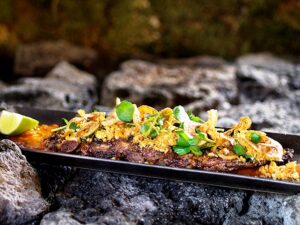 Velkomin á Grillmarkaðinn, or in English, Welcome to the Grillmarket. “Local” was the key word for me. Their promo: A close working collaboration with dedicated local farmers. The very best in local seasonal produce. Local products include lamb, beef, trout, quail, skyr, and honey. We highlight the origin of each product while using fire, smoke, fire logs, and coal. Our grill is custom made; the coals heat up to 1200 degrees Celsius; the food cooks crispy on the outside and remains juicy and succulent on the inside. The outcome is a culinary treat where Icelandic heritage and the modern age meet. Our menu is a magical fusion of tradition and modern cuisine. My comment: everything from beef to whale! https://www.grillmarkadurinn.is/en/
Velkomin á Grillmarkaðinn, or in English, Welcome to the Grillmarket. “Local” was the key word for me. Their promo: A close working collaboration with dedicated local farmers. The very best in local seasonal produce. Local products include lamb, beef, trout, quail, skyr, and honey. We highlight the origin of each product while using fire, smoke, fire logs, and coal. Our grill is custom made; the coals heat up to 1200 degrees Celsius; the food cooks crispy on the outside and remains juicy and succulent on the inside. The outcome is a culinary treat where Icelandic heritage and the modern age meet. Our menu is a magical fusion of tradition and modern cuisine. My comment: everything from beef to whale! https://www.grillmarkadurinn.is/en/
In the Beginning
- BEEF CARPACCIO Chili jam, sweet almonds, herb pesto and ruccola
- BURRATA Icelandic artisan cheese from Skagafjörður region, rainbow tomatoes and almond pesto
- CHICKEN WINGS Sweet soy dressing, smoked birch salt and lime
- GRILLED PORK RIBS Grillmarket dressing, rice cakes, watercress and drizzled with honey
- GRILLED PUFFIN Lightly smoked puffin, pickled bilberries and mushrooms
- GRILLED WHALE STEAK Tender steak of whale, lime and soy vinaigrette
- HORSE “WAGYU” TATAKI Apple, Cilantro, Crispy Jerusalem artichokes and miso vinaigrette
- LOBSTER TEMPURA Chili mayonnaise, oats and roasted garlic
- SHELLFISH SOUP Icelandic shrimps, mini scallops and langoustine
- VEGETABLES, DEEP-FRIED IN CRISPY BATTER Mixed vegetables with organic Greek yogurt
Course
- GRILLED LAMB CHOPS Crispy potatoes, glazed carrots and spiced nut crumble
- GRILLED MOUNTAIN CHAR Almond pesto, potato purée and caramelized onions from Vallanes
- LIGHTLY SALTED COD Grilled apple purée, black garlic, langoustine salad and shellfish sauce
- VEGAN PEANUT STEAK Our vegetarian choice is made from nuts, beans and seasonal vegetables
Big Steaks
- BEEF TENDERLOIN The best part of the beef, the steak has been prepared to perfection and is very flavourful
- HORSE TENDERLOIN The most tender part of the horse
- PORTERHOUSE cut from the short loin and includes the tenderloin; the bone separating these muscles gives the steak its divine flavour
- RIB EYE OF BEEF is a steak from the rib section with perfect marbling
- STEAKS FROM ICELANDIC FARMERS served with mushrooms glaze, Grillmarket fries and pan fried vegetables
- STEAKS FROM THE FARM MIÐEY We handpick our steaks from Miðey farm and the meat is aged for at least 35 days
- TOMAHAWK STEAK, garlic potatoes, aspargus, broccolini and bearnaise sauce
On the Side
- FRIED MUSHROOMS Chestnut mushrooms, oyster mushrooms and garlic
- GARLIC POTATOES Deep fried and seasoned with garlic sauce
- GREEN SALAD
- GRILLED ASPARAGUS & BROCCOLINI
- GRILLED CORN COB With Icelandic heart butter
- GRILLMARKET FRIES Deep fried and seasoned with garlic and dill
- PAN FRIED VEGETABLES Kale, carrots, mushrooms and parsnip root
Sweet Endings
- BERRY CRUMBLE Mixed berries, crunchy oats and dulche de leche caramel
- CHOCOLATE TART Toffee filled chocolate cake with salted caramel ice cream
- DESSERT PLATTER Selection of desserts, exotic fruits, ice cream and sorbets
- GRILLMARKET CHOCOLATE Mascarpone mousse, warm caramel and coffee ice cream
- HOMEMADE ICE CREAM BLISS Exquisite ice cream and sorbets with four different flavors
Forgive any misspelled Icelandic words. And forgive the printing of entire menus. Consider them as an encyclopedia of food choices in Iceland!
» posted on Wednesday, August 17th, 2022 by Linda Lou Burton
This Is The One I Want!
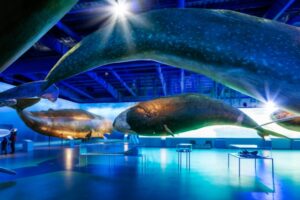 Originally published August 11, 2020 by Linda Lou Burton posting about Reykjavik, Iceland from Little Rock, Arkansas – Yesterday we saw a lot of Reykjavik. We ate the famous hot dogs, we visited the Whales of Iceland museum, and we strolled the streets getting pictures of the street art (it really is everywhere) and the really pointy church; different styles of architecture for sure. We even had time to visit the US Embassy and register our names. But the hardest thing – we had to pick our next-day tour.
Originally published August 11, 2020 by Linda Lou Burton posting about Reykjavik, Iceland from Little Rock, Arkansas – Yesterday we saw a lot of Reykjavik. We ate the famous hot dogs, we visited the Whales of Iceland museum, and we strolled the streets getting pictures of the street art (it really is everywhere) and the really pointy church; different styles of architecture for sure. We even had time to visit the US Embassy and register our names. But the hardest thing – we had to pick our next-day tour.
I’ve been on a submarine tour in Hawaii with Kayla (Yellow on the Submarine) https://capitalcitiesusa.org/?p=2424, and a circle-the-island tour and even an inside-the crater tour; and hula dancing of course. Sam and I spent a day with sled dogs and mushers in Alaska (Dog Day Afternoon) https://capitalcitiesusa.org/?p=4895, we also went whale watching (and saw whales!), and glacier spotting, driving every paved road in Juneau. Oh, a salmon fishery too. But we had ten days to play on those trips; here we’ve only got ONE FULL 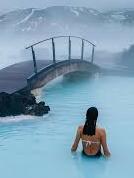 DAY to tour Iceland. And Iceland offers a literal buffet of touring opportunities. This tiny county with a population of 364,134 people and an area of 40,000 square miles is nothing short of unbelievable in “things to do.” There are Snorkeling Tours and Secret Lagoon Tours; Ice
DAY to tour Iceland. And Iceland offers a literal buffet of touring opportunities. This tiny county with a population of 364,134 people and an area of 40,000 square miles is nothing short of unbelievable in “things to do.” There are Snorkeling Tours and Secret Lagoon Tours; Ice  Cave Tours and Glacier Hikes; Kayaking, Snowmobiling, Horseback Riding and even just plain Sightseeing Tours. We quickly ruled out the Golden Circle Tour – it covers a lot of territory, circling the island, but it meant we’d spend a lot of time riding the bus.
Cave Tours and Glacier Hikes; Kayaking, Snowmobiling, Horseback Riding and even just plain Sightseeing Tours. We quickly ruled out the Golden Circle Tour – it covers a lot of territory, circling the island, but it meant we’d spend a lot of time riding the bus.
Sam was interested in snorkeling; “Listen to this – Join one of our snorkeling tours to Silfra Fissure, the only place in the world where you can snorkel between two continental plates. Amazingly, there are places within Silfra where it is possible to touch the rock on either side.”
Snorkel between two continental plates!
Kayla spotted a hiking tour; “Listen to this – Hike to the colorful Highlands, a unique bubbling geothermal wonderland with caramel color peaks, soothing hot springs, rambling lava flows and clear blue lakes; located in Fjallabak Reserve in the remote highlands of Iceland.”
Hot Springs and Lava Flows!
They both shook their heads. Too hard to gather the underwater gear needed; too much time in one spot; hiking is slow; great tours, but too limited.
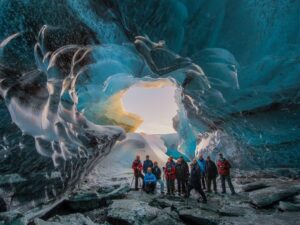 “I really want to see the ice caves,” Kayla said then, scanning the list. “Listen to this — Katla Ice Cave (Under The Volcano) Tour. Jump in a Super Jeep, strap on your crampons and step into the mighty glaciers and ice caves of South Iceland. Hike across the Myrdalsjokull glacier, then visit the amazing blue and black ice cave of Kötlujökull glacier on Mt. Katla. Enchanting glaciers and mountains surround us along the way. We stop near the roots of Kötlujökull glacier and the view is otherworldly. Crampons and helmets on, a short walk to the opening of the ice cave. Beautiful layers of different colored ice and volcanic ash paint impressive stripes in the glacier. Your guide tells the history of the glacier, the ice cave and the area around it. Back out from the glacier we look for smaller accessible ice caves
“I really want to see the ice caves,” Kayla said then, scanning the list. “Listen to this — Katla Ice Cave (Under The Volcano) Tour. Jump in a Super Jeep, strap on your crampons and step into the mighty glaciers and ice caves of South Iceland. Hike across the Myrdalsjokull glacier, then visit the amazing blue and black ice cave of Kötlujökull glacier on Mt. Katla. Enchanting glaciers and mountains surround us along the way. We stop near the roots of Kötlujökull glacier and the view is otherworldly. Crampons and helmets on, a short walk to the opening of the ice cave. Beautiful layers of different colored ice and volcanic ash paint impressive stripes in the glacier. Your guide tells the history of the glacier, the ice cave and the area around it. Back out from the glacier we look for smaller accessible ice caves 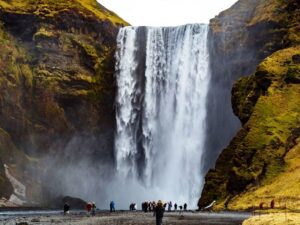 before returning to our super truck. Then we’ll swing by some majestic waterfalls — the Eerie waterfall of Skógafoss which is the inspiration to dozens of folklore tales. Hike up the right side of the waterfall to see the troll’s face that stares at the waterfall for all eternity after forgetting time and turning into stone. Stop at the stunning Seljalandsfoss waterfall, the one you can walk behind; it is located on the Seljalands River which flows from the famous volcano, Eyjafjallajökull! Back in Reykjavik around 8:00 p.m. Make sure to bring your camera! “
before returning to our super truck. Then we’ll swing by some majestic waterfalls — the Eerie waterfall of Skógafoss which is the inspiration to dozens of folklore tales. Hike up the right side of the waterfall to see the troll’s face that stares at the waterfall for all eternity after forgetting time and turning into stone. Stop at the stunning Seljalandsfoss waterfall, the one you can walk behind; it is located on the Seljalands River which flows from the famous volcano, Eyjafjallajökull! Back in Reykjavik around 8:00 p.m. Make sure to bring your camera! “
This is the one I want! said Kayla.
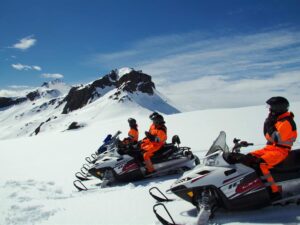 “Too much hiking,” Sam said. “Listen to this one — Combine Snowmobiling on Langjökul Glacier with an Ice Cave Exploration. Pickup up in Reykjavik or Gullfoss Café, head to Langjökull Glacier in the Icelandic Highlands in our super truck. From here you can see Eiríksjökull Glacier (the highest mountain in west Iceland), Hofsjökull Glacier and the Kerlingafjöll Mountains. Your certified glacier guide provides overalls, helmet and all the gear you need, gives you a safety briefing and snowmobile driving instructions. You are then ready to ride – your stunning 1-hour snowmobile ride takes you across Langjökull Glacier, the second largest glacier in Iceland; it feels like a magic carpet chase across the roof of majestic white land. Langjökull Ice Cave is a totally spellbinding stunner; this is ‘The
“Too much hiking,” Sam said. “Listen to this one — Combine Snowmobiling on Langjökul Glacier with an Ice Cave Exploration. Pickup up in Reykjavik or Gullfoss Café, head to Langjökull Glacier in the Icelandic Highlands in our super truck. From here you can see Eiríksjökull Glacier (the highest mountain in west Iceland), Hofsjökull Glacier and the Kerlingafjöll Mountains. Your certified glacier guide provides overalls, helmet and all the gear you need, gives you a safety briefing and snowmobile driving instructions. You are then ready to ride – your stunning 1-hour snowmobile ride takes you across Langjökull Glacier, the second largest glacier in Iceland; it feels like a magic carpet chase across the roof of majestic white land. Langjökull Ice Cave is a totally spellbinding stunner; this is ‘The  White Glacier’ and the Ice Cave is the most amazing bright jewel blue ice imaginable. The ice-ceiling above you resembles a brilliant blue river, the ice is so exceptionally translucent, it seems as though you are surrounded by pure blue-hued quartz crystal jewels. The ice around this ‘blue river´ is white, with unusual gray ‘zebra striping’ from the ash layers of various volcanic eruptions. Explore and photograph the cave and enjoy the rare and precious crystalline blue beauty of this amazing natural ice cavern. Outside, your trusty snowmobile is waiting, ready to skim you across Langjökull to our Snowmobile Base Camp and then Gullfoss Café, beside the famous waterfall.
White Glacier’ and the Ice Cave is the most amazing bright jewel blue ice imaginable. The ice-ceiling above you resembles a brilliant blue river, the ice is so exceptionally translucent, it seems as though you are surrounded by pure blue-hued quartz crystal jewels. The ice around this ‘blue river´ is white, with unusual gray ‘zebra striping’ from the ash layers of various volcanic eruptions. Explore and photograph the cave and enjoy the rare and precious crystalline blue beauty of this amazing natural ice cavern. Outside, your trusty snowmobile is waiting, ready to skim you across Langjökull to our Snowmobile Base Camp and then Gullfoss Café, beside the famous waterfall.
This is the one I want! said Sam.
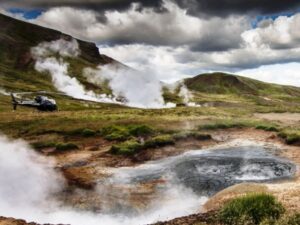 Meanwhile, I was doing my own plotting. Our ages are transposed – 18 and 81 — and so are our energy levels. I am way too claustrophobic to go into a cave of any kind, no matter how beautiful. My footing in too unstable to walk on ice, and even on an IMAGINARY RTW I can’t imagine wanting to drive a snowmobile. I wanted to see the countryside, especially the geothermals. But I didn’t want to sit on a bus with a lot of other tourists. “Listen to this,” I said. “Geothermal Iceland – Helicopter Tour. Geothermal pools, power plants, lava fields, craters & Reykjavik. Discover Iceland’s geothermal energy from the quiet and comfortable seat of a helicopter. Soar above the volcanic landscape, over geothermal pools and power plants, lava fields and craters. A brief landing to witness the raw, primeval energy rising up from the earth. Fly
Meanwhile, I was doing my own plotting. Our ages are transposed – 18 and 81 — and so are our energy levels. I am way too claustrophobic to go into a cave of any kind, no matter how beautiful. My footing in too unstable to walk on ice, and even on an IMAGINARY RTW I can’t imagine wanting to drive a snowmobile. I wanted to see the countryside, especially the geothermals. But I didn’t want to sit on a bus with a lot of other tourists. “Listen to this,” I said. “Geothermal Iceland – Helicopter Tour. Geothermal pools, power plants, lava fields, craters & Reykjavik. Discover Iceland’s geothermal energy from the quiet and comfortable seat of a helicopter. Soar above the volcanic landscape, over geothermal pools and power plants, lava fields and craters. A brief landing to witness the raw, primeval energy rising up from the earth. Fly  over the Hengill volcano, which is still active, as evidenced by numerous hot springs and fumaroles in the area. Stop here to see the hot springs, calcium-rich solfatara and boiling water running several feet under the earth’s surface, producing a multitude of steaming fumaroles all around. This volcano is an important source of energy for the country, which is utilized at the Nesjavellir and the Hellisheidi power stations, where groundwater is heated and distributed to the district. Our tour concludes after ascending over Reykjavik, with a great aerial overview of the colorful houses of the city.”
over the Hengill volcano, which is still active, as evidenced by numerous hot springs and fumaroles in the area. Stop here to see the hot springs, calcium-rich solfatara and boiling water running several feet under the earth’s surface, producing a multitude of steaming fumaroles all around. This volcano is an important source of energy for the country, which is utilized at the Nesjavellir and the Hellisheidi power stations, where groundwater is heated and distributed to the district. Our tour concludes after ascending over Reykjavik, with a great aerial overview of the colorful houses of the city.”
This is the one I Want! said Linda.
When we get back to our room tonight, what great stories we’ll have to share.
Iceland Day Tours https://adventures.is/iceland/day-tours/
» posted on Monday, August 15th, 2022 by Linda Lou Burton
Time Travel
Originally published by Linda Lou Burton posting about Reykjavik, Iceland from Little Rock, Arkansas – I made it to Reykjavik before dark last night. Way before dark, in fact, as the sun doesn’t set here until 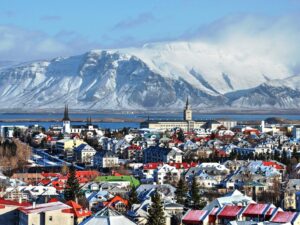 10 PM and I arrived at 7. And I only changed two time zones, so sleep patterns weren’t affected that much. Everything else was affected though; as anticipated – temperature was the first thing I noticed. Highs of 95 in Cairo, and throat-parching dry; it’s 57 here, and rainy this morning. But I like cool better than hot, and “cool with rain” is fairly normal for the kids, coming from Seattle. But their sleep-brain will surely take a hit! Iceland Air flies non-stop
10 PM and I arrived at 7. And I only changed two time zones, so sleep patterns weren’t affected that much. Everything else was affected though; as anticipated – temperature was the first thing I noticed. Highs of 95 in Cairo, and throat-parching dry; it’s 57 here, and rainy this morning. But I like cool better than hot, and “cool with rain” is fairly normal for the kids, coming from Seattle. But their sleep-brain will surely take a hit! Iceland Air flies non-stop 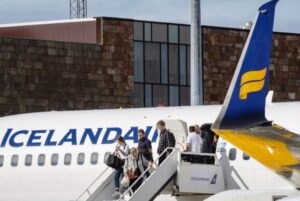 from Seattle to Reykjavik in 8 hours. And, Reykjavik time is 7 hours ahead of Seattle time. So do the math: if they got on their plane at 7 PM Sunday, it was 2 AM Monday in Reykjavik, and I was fast asleep. When I meet their plane at 10 this morning, their brain will likely be saying, “Leave me alone! It’s only 3 AM!”
from Seattle to Reykjavik in 8 hours. And, Reykjavik time is 7 hours ahead of Seattle time. So do the math: if they got on their plane at 7 PM Sunday, it was 2 AM Monday in Reykjavik, and I was fast asleep. When I meet their plane at 10 this morning, their brain will likely be saying, “Leave me alone! It’s only 3 AM!”
Or maybe they’ll be excited. Kayla was taken to the Philippines when she was a baby, but has no memories of that. And for Sam, it’s his first trip beyond US soil. They were both enthusiastic about my graduation-gift invite; pleased as punch, and (until COVID-19 shut us down and turned our trip into Now Defunct Imaginary) raring to go. Maybe it was the hype I sent them. After all, most people don’t know much about Iceland. Do you?
Reykjavik: Quick & Quirky Facts
- Reykjavik is the northernmost capital of a sovereign state in the world.
- Reykjavik is among the cleanest, greenest, and safest cities in the world.
- Reykjavik was the first permanent settlement in Iceland in 874 AD.
- Reykjavik means “smoky bay,” referring to the steam rising from the hot springs and geothermal vents.
- Reykjavik is the only Western European capital without a Starbucks or a McDonald’s.
- Reykjavik is the only capital city in the world that is home to a puffin colony.
- Reykjavik is mostly a cat city, as dogs were banned from 1924 to 1984.
- Reykjavik has a penis museum called the Icelandic Phallological Museum.
Quirky indeed! And after just leaving one of the most dangerous capital cities in the world, I must say I feel relaxed about bringing my grandkids to one of the safest. Iceland has been near the top of 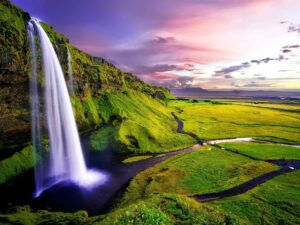 the list of safest countries in the world for decades and Reykjavik has topped the list of safest cities. The crime rate here is unbelievably low; scams, racism, homophobia, violence, and sexual harassment are almost nonexistent. Still, when most folks hear the word “Iceland” they imagine a cold, unfriendly place. Nothing could be further from the truth! It may lie almost within the Arctic Circle, but the North Atlantic Current warmed by Gulf Stream waters makes the climate of Iceland more temperate than most places with similar latitudes. And the easy-to-access scenery is stunning — waterfalls, glaciers, ice caves, volcanic peaks, geysers, geothermal pools, and the sea, so close.
the list of safest countries in the world for decades and Reykjavik has topped the list of safest cities. The crime rate here is unbelievably low; scams, racism, homophobia, violence, and sexual harassment are almost nonexistent. Still, when most folks hear the word “Iceland” they imagine a cold, unfriendly place. Nothing could be further from the truth! It may lie almost within the Arctic Circle, but the North Atlantic Current warmed by Gulf Stream waters makes the climate of Iceland more temperate than most places with similar latitudes. And the easy-to-access scenery is stunning — waterfalls, glaciers, ice caves, volcanic peaks, geysers, geothermal pools, and the sea, so close.
Things That May Surprise You On An August Visit
- Does the sun set in Iceland in August? From mid-May to mid-August the sun only sets for only a few hours per day, and it is effectively light for the whole 24-hour period.
- What does Iceland feel like in August? August is one of the warmest months of the year in Iceland. The average daily temperature hovers around 50-59°F, but it can leap up to 77°F.
- Is it worth going to Iceland in August? Absolutely! August is the perfect time to be visiting Iceland, especially if you like adventures, local events and outdoor activities.
- Can you see the northern lights in Reykjavik in August? The northern lights are visible in August, but since it never gets properly dark it’s the wrong time for good viewing.
- Do you need insect repellent in Iceland? Iceland is completely free of mosquitoes, and ants, though small midges thrive in the summertime, especially by lakes and streams.
- Are there any dangerous animals in Iceland? No, and there are no snakes in Iceland. Don’t bother the eggs in bird nests though, you may get pecked.
- What is a typical breakfast in Iceland? Yogurt, berries, fruit, eggs, cheese, bacon, sausage, fried potatoes, pancakes, sourdough bread, and Icelandic butter. Juice, coffee, tea.
- Do you need cash in Iceland? The currency in Iceland is the Icelandic króna (ISK). Many places take US dollars, but Icelanders usually pay for everything by credit or debit card.
- Is tipping in Iceland an insult? Tipping is not customary in Iceland. The server’s wages are sufficient and they don’t expect it. If you want to give someone a tip, by all means do.
 Tipping an insult! The server’s wages are sufficient! What a country! Well, it’s time to go to the airport to meet Kayla and Sam and see if they’re awake enough to have some fun. I’ve already sent them a list of 15 things to choose from. I expect food may be their first concern though. Since FISH takes up the most space on restaurant menus (and neither of them care for fish), they will be surprised to learn that the humble HOT DOG is so popular in Iceland it is the unofficial national food. Bill Clinton tried one when he was here!
Tipping an insult! The server’s wages are sufficient! What a country! Well, it’s time to go to the airport to meet Kayla and Sam and see if they’re awake enough to have some fun. I’ve already sent them a list of 15 things to choose from. I expect food may be their first concern though. Since FISH takes up the most space on restaurant menus (and neither of them care for fish), they will be surprised to learn that the humble HOT DOG is so popular in Iceland it is the unofficial national food. Bill Clinton tried one when he was here!
» posted on Sunday, August 14th, 2022 by Linda Lou Burton
Way Cool
Originally published August 9, 2020 by Linda Lou Burton posting about Cairo, Egypt and Reykjavik, Iceland from Little Rock, Arkansas – Fortunately I woke up from my Charlton Heston dream, it’s time to pack, and go. I must be thinking FAMILY today, getting excited about the grandkids that join me tomorrow in Reykjavik.
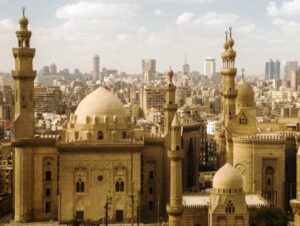 But I haven’t yet written anything really positive about Cairo. Like its designation as “city of a thousand minarets,” and the Old City, which includes the site of a Roman-era fortress and Islamic-era settlements pre-dating the founding of Cairo. Pretty awesome stuff, that you can only see right here; I should have planned longer to explore. There are cultural tours, historical tours, art tours, and even ghost tours. I’ve done the top rated suggestions – the Pyramids and the Nile cruise. But I haven’t mentioned the many parks in the city, or delved into the food scene at all.
But I haven’t yet written anything really positive about Cairo. Like its designation as “city of a thousand minarets,” and the Old City, which includes the site of a Roman-era fortress and Islamic-era settlements pre-dating the founding of Cairo. Pretty awesome stuff, that you can only see right here; I should have planned longer to explore. There are cultural tours, historical tours, art tours, and even ghost tours. I’ve done the top rated suggestions – the Pyramids and the Nile cruise. But I haven’t mentioned the many parks in the city, or delved into the food scene at all.  Most of the posh hotels offer five-star dining; and it’s cheaper here than in many countries. Lots of international choices – Spanish, Indonesian, Vietnamese, and traditional Egyptian of course; lots of rooftop and riverside dining if you don’t want to brave the bustling local spots. Looking for
Most of the posh hotels offer five-star dining; and it’s cheaper here than in many countries. Lots of international choices – Spanish, Indonesian, Vietnamese, and traditional Egyptian of course; lots of rooftop and riverside dining if you don’t want to brave the bustling local spots. Looking for 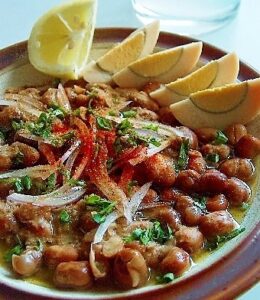 seafood, sushi, steak, or ful medames? Ful medames is a stew of fava beans, with garlic, onion, chili pepper and other vegetables; a staple in Egypt. Egyptian cuisine makes heavy use of legumes, vegetables, and fruit from the rich Nile Valley and Delta, similar to Eastern Mediterranean cooking. Rice-stuffed vegetables, grape leaves, kebabs; common meats are chicken and lamb. Tea is the national drink.
seafood, sushi, steak, or ful medames? Ful medames is a stew of fava beans, with garlic, onion, chili pepper and other vegetables; a staple in Egypt. Egyptian cuisine makes heavy use of legumes, vegetables, and fruit from the rich Nile Valley and Delta, similar to Eastern Mediterranean cooking. Rice-stuffed vegetables, grape leaves, kebabs; common meats are chicken and lamb. Tea is the national drink.
Cairo International (CAI); Egyptian Air this time, flying 2,000 miles north over Greece, Croatia, Austria, and Germany before a stop in Copenhagen, Denmark (CPH) for a few hours. Then 1,330 miles in a northwesterly direction over the the tip of Norway and the North Sea to Reykjavik, Iceland (KEF) and the biggest change on the entire trip.
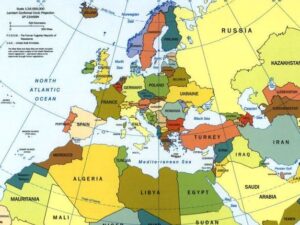 First of all, two of my grandkids arrive in the morning from Seattle; so the rest of the trip is “family time” instead of a singular experience. Then there is climate change, geography change, food change, and even “daylight” change – that far north we’ll have 17 hours of
First of all, two of my grandkids arrive in the morning from Seattle; so the rest of the trip is “family time” instead of a singular experience. Then there is climate change, geography change, food change, and even “daylight” change – that far north we’ll have 17 hours of 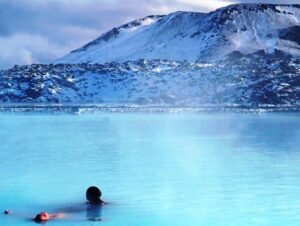 summer daylight to play. From the heat and humidity of Thailand and UAE and Egypt; from palm trees and monkeys and sand and camels; from Aboriginal and Buddhist and Islamic religions; from a generally hectic pace to the no-frills Lutheran way of life, where fish top every menu, swimming in geothermal pools is a year-round habit, and there’s not a poisonous snake to be found.
summer daylight to play. From the heat and humidity of Thailand and UAE and Egypt; from palm trees and monkeys and sand and camels; from Aboriginal and Buddhist and Islamic religions; from a generally hectic pace to the no-frills Lutheran way of life, where fish top every menu, swimming in geothermal pools is a year-round habit, and there’s not a poisonous snake to be found.
Just a wee bit south of the Arctic Circle – Reykjavik, Iceland, the northernmost capital city in the world. Way cool.
» posted on Friday, July 1st, 2022 by Linda Lou Burton
Deja Re-View
No Mask Needed This Way, July 1, 2020
Originally published July 1, 2020 by Linda Lou Burton posting from Little Rock, Arkansas – I had a friend who had 366 notebooks lining the shelves of his office, labeled with each day of the year, yes, even including Leap. Every day he added a new page in the proper notebook . He could tell you exactly what he was doing, and thinking, and feeling, on any day as far back as twenty years.
On February 29 of this Leap Year, I got news of the first case of the COVID-19 virus in the United States. I was standing in the arena at the fairgrounds here in Little Rock, attending the state Flower & Garden Show with a friend. She was checking her phone for messages, and the news popped up. “Where?” I asked. I’d spent the last month booking reservations for my Round The World trip in July that would take me to the last two continents on my list of seven – Australia and Asia. I had scrupulously avoided China in the plan, due to rumblings of a highly contagious disease and contaminated cruise ships there.
When she told me the case was in Seattle, I was not only startled, but genuinely alarmed, as it was precisely in the area where two of my sons live, with their families. Six grandchildren there! And, Seattle was to be the first stop on the Journey Round The World. My flight was booked for July 7.
“Oh, it will all be done by May,” was the line on everybody’s lips. “Don’t worry.”
I have been tracking the numbers since March 1. As of today 2,624,873 cases have been reported in the United States and its territories by the Centers for Disease Control; with 127,299 deaths from the disease. The only “US soil” that has remained virus-free is American Samoa, which was to be a major stop on my RTW.
There were several kinds of things the RTW would tick off my list of “things to do before I die” (aka Bucket List). I could claim all seven continents as mine; and all five oceans. I would visit the southernmost and northernmost capital cities in the world – Wellington, New Zealand and Reykjavik, Iceland. I would cruise the longest rivers on the continents of Australia and Africa – the Murray and the Nile. I would visit two wonders of the world – Ayers Rock or Uluru, the giant red monolith in the heart of Australia; and the Sphinx and the Pyramids of Giza in Egypt. I would visit three far-flung US National Parks – Haleakala and Hawaii Volcanoes in Hawaii; American Samoa in – well, American Samoa. And best of all, I would add nine world capital cities to my Capital City list! With the added bonus of having my two youngest grandchildren join me in Reykjavik as a “high school graduation gift,” with my RTW ending in Washington, DC with grandkids, in an election year!
This trip would be a crown in my crowns. The grandkids, Kayla and Sam, had been a part of the Journey Across America in 2012; Kayla to Honolulu with me; Sam to Juneau. Now those 4th graders are done with high school! And what a (excuse the language please) SUCKY senior year they were served; schools were closed in March so no senior prom, no bonding with friends, just a Virtual Do and, that’s it. Also, sadly, no trip to Reykjavik, and Washington, DC.
I am now 81 years old, and although the airlines have offered “rebooking” opportunities in years to come, I don’t plan to travel worldwide until the word “pandemic” is erased from our daily conversation and the (currently non-existent) vaccine is keeping everyone, all over the world, SAFE from COVID-19.
So, here’s the deal. I’ll do my traveling VIRTUALLY, and tell you all about it. Plus, I’ll review and update the 51 wonderful capitals I visited on the Journey Across America. I’ve always believed the best thing about travel is the memories; they never RUST or wear out. They nurture you when you are “too old to rock the rocking chair.” (And I am getting close to that.)
On July 1, 2012, I had just returned from Honolulu with Kayla, and was settling in for a two-week stint in Olympia, the capital city of Washington. It was a cool, gray day, as my cats Alex and Jack settled in with me in a peaceful spot.
On July 1, 2013, I was in Des Moines, the capital city of Iowa, where one expected the corn to be “knee high by the 4th of July.” I learned a lot about pigs there too, and genuine Midwestern friendliness.
Today, July 1, 2020, I live in Little Rock, the capital city of Arkansas, with my Katy cat, where Social Distancing is now the required norm, and face masks the recommended attire.
Still in love with capital cities. Still enjoying the world we live in.
Go with me? You won’t even need a face mask!
Knee High By The 4th of July, July 1, 2013
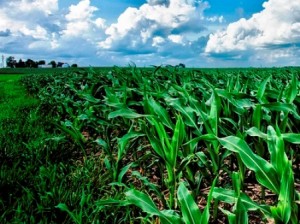 Linda Burton posting from Des Moines, Iowa – “Oh What A Beautiful Morning!” Remember that Rodgers & Hammerstein tune from Oklahoma? Driving through the Iowa countryside a few days ago, with early summer cornfields rolling across the hills to my right and to my left, I thought of a line from that song “….the corn is as high as an elephants eye….” Then I laughed, because the corn I saw was just beginning to get a grip on growing; it’s pretty darned early in the season here. “That corn is only knee high,” I thought. Later I learned that’s the catch-phrase of corn farmers: “We look for the corn to be knee high by the 4th of July,” I was told. That’s the
Linda Burton posting from Des Moines, Iowa – “Oh What A Beautiful Morning!” Remember that Rodgers & Hammerstein tune from Oklahoma? Driving through the Iowa countryside a few days ago, with early summer cornfields rolling across the hills to my right and to my left, I thought of a line from that song “….the corn is as high as an elephants eye….” Then I laughed, because the corn I saw was just beginning to get a grip on growing; it’s pretty darned early in the season here. “That corn is only knee high,” I thought. Later I learned that’s the catch-phrase of corn farmers: “We look for the corn to be knee high by the 4th of July,” I was told. That’s the 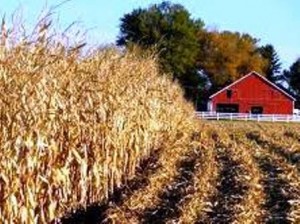 assurance that everything is on track; “elephant’s eye” corn isn’t expected until late September; most harvesting happens in October and sometimes into November. Then there’s a lot of harvesting going on; in 2012 Iowa corn farmers grew almost 1.88 billion bushels of corn, on 13.7 million acres of land; 2013 projections indicate 2.45 billion bushels on 13.97 million acres. Iowa has produced the largest corn crop of any state for more than two decades; in an average year, Iowa produces more corn than most countries! And it’s been the dominant
assurance that everything is on track; “elephant’s eye” corn isn’t expected until late September; most harvesting happens in October and sometimes into November. Then there’s a lot of harvesting going on; in 2012 Iowa corn farmers grew almost 1.88 billion bushels of corn, on 13.7 million acres of land; 2013 projections indicate 2.45 billion bushels on 13.97 million acres. Iowa has produced the largest corn crop of any state for more than two decades; in an average year, Iowa produces more corn than most countries! And it’s been the dominant  crop in Iowa for more than 150 years. The reasons are simple – a growing season that is long enough and warm enough, ample rain, and deep, rich soil. Iowa also produces livestock whose waste includes nutrients that are key to fertilizing the fields for better corn production. According to Iowa Agriculture farm statistics, in 2012 there were 195,000 sheep and lambs on hand, 3.9 million cattle and calves, and 20 million hogs. And, by the way, Iowa is the number one pork producing state in the country too.
crop in Iowa for more than 150 years. The reasons are simple – a growing season that is long enough and warm enough, ample rain, and deep, rich soil. Iowa also produces livestock whose waste includes nutrients that are key to fertilizing the fields for better corn production. According to Iowa Agriculture farm statistics, in 2012 there were 195,000 sheep and lambs on hand, 3.9 million cattle and calves, and 20 million hogs. And, by the way, Iowa is the number one pork producing state in the country too.
I went to the Iowa Agriculture website for some basic farm facts; I wanted to know how many farms there are in Iowa, overall. The answer (as of 2011) is 92,300 farms, covering 30.7 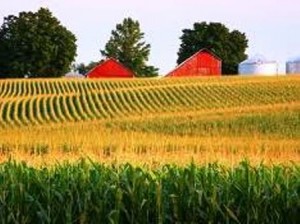 million acres of the state. The size of an average farm is 333 acres, valued at about $6,708 per acre. That long growing season I mentioned has temperatures ranging from an average of 13.2F in January to 75.3F in July, with an average annual rainfall of 45.10 inches. Soybeans, milk, and eggs are other biggies in the state; 466 million bushels of soybeans grown on 9.23 million acres in 2011; 4.33 billion pounds of milk produced; 14.5 billion eggs. Equate that to how many glasses of milk you drink in a week, or how many sunny-side-up breakfasts you enjoy. As to the bacon that accompanies those breakfast eggs – I pulled some numbers from the National Pork Board and the US Census of Agriculture. Iowa has about 8,300 hog operations; more than 39,000 jobs are directly related to raising and caring for hogs in Iowa; the industry generates nearly $950 million in household income for pork producers.
million acres of the state. The size of an average farm is 333 acres, valued at about $6,708 per acre. That long growing season I mentioned has temperatures ranging from an average of 13.2F in January to 75.3F in July, with an average annual rainfall of 45.10 inches. Soybeans, milk, and eggs are other biggies in the state; 466 million bushels of soybeans grown on 9.23 million acres in 2011; 4.33 billion pounds of milk produced; 14.5 billion eggs. Equate that to how many glasses of milk you drink in a week, or how many sunny-side-up breakfasts you enjoy. As to the bacon that accompanies those breakfast eggs – I pulled some numbers from the National Pork Board and the US Census of Agriculture. Iowa has about 8,300 hog operations; more than 39,000 jobs are directly related to raising and caring for hogs in Iowa; the industry generates nearly $950 million in household income for pork producers.
Enough with the numbers; I wanted to know what kind of hogs are raised, and what is different about each breed. But first a little Pig Latin Lesson: “boars” are males of breeding  age; “sows” are breeding females; and “piglets” need no explanation; they are the unweaned little ones.
age; “sows” are breeding females; and “piglets” need no explanation; they are the unweaned little ones.
From the Des Moines National Pork Board website, which also has delicious recipes for the use of pork, I learned that most hogs bred for consumption are the offspring of a combination of breeds – usually dark-breed boars bred to white-breed sows. Dark breed boars enhance meat quality; white-breed sows produce many piglets, plus their maternal instincts allow more piglets to survive. A producer will choose a particular breed, or combination of genetic lines, based on what they are looking for with regard to meat quality, farming method, and the hog market. Here are eight of the most widely popular.
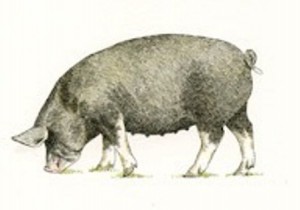 Berkshire. A black pig that originated in Britain in the mid-1500s, prized for juiciness, flavor, and tenderness, yielding a pink-hued, heavily marbled meat suitable for long cooking times.
Berkshire. A black pig that originated in Britain in the mid-1500s, prized for juiciness, flavor, and tenderness, yielding a pink-hued, heavily marbled meat suitable for long cooking times.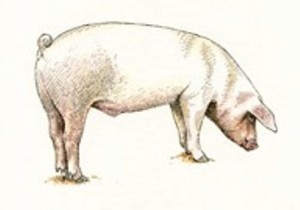 Chester White. Used in commercial crossbreeding; originated in Pennsylvania in the early 1800s when white pigs common to the northeast US were bred with a white boar imported from Bedfordshire, England.
Chester White. Used in commercial crossbreeding; originated in Pennsylvania in the early 1800s when white pigs common to the northeast US were bred with a white boar imported from Bedfordshire, England. Duroc. Known for quick growth; red or black coloring; the second most recorded breed in the US; a main sire choice of American farmers. Sweet meat, amazing shoulders and spareribs.
Duroc. Known for quick growth; red or black coloring; the second most recorded breed in the US; a main sire choice of American farmers. Sweet meat, amazing shoulders and spareribs. Hampshire. Fourth most recorded breed in America and oldest American breed in existence; stock imported from Wessex, England in 1832. Black with a white belt across the shoulders, a lean-meat breed.
Hampshire. Fourth most recorded breed in America and oldest American breed in existence; stock imported from Wessex, England in 1832. Black with a white belt across the shoulders, a lean-meat breed.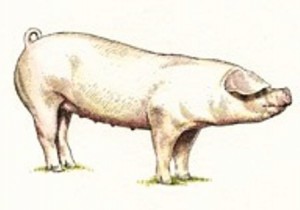 Landrace. Fifth most recorded breed in the US; known for large litters of piglets. A white pig, descended from the Danish Landrace; produces a large and flavorful ham and loin.
Landrace. Fifth most recorded breed in the US; known for large litters of piglets. A white pig, descended from the Danish Landrace; produces a large and flavorful ham and loin.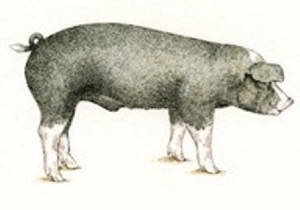 Poland China. Black with white face and feet, derives from many breeds, including the Berkshire and the Hampshire. Known for large size; one of the most common breeds in the US.
Poland China. Black with white face and feet, derives from many breeds, including the Berkshire and the Hampshire. Known for large size; one of the most common breeds in the US. Spotted Pig. Black and white spots, no red or brown; popular in the US because of high meat quality and ability to gain weight quickly.
Spotted Pig. Black and white spots, no red or brown; popular in the US because of high meat quality and ability to gain weight quickly.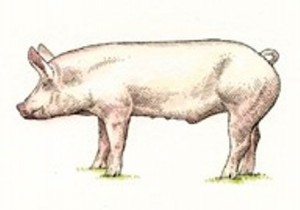 Yorkshire. #1 recorded breed in the US; white, very durable and muscular, high proportion of lean meat. Developed in the county of York, England, and brought to the US around 1830.
Yorkshire. #1 recorded breed in the US; white, very durable and muscular, high proportion of lean meat. Developed in the county of York, England, and brought to the US around 1830.
Now that you’re up on pigs, let’s get back to corn. Because, you see, most Iowa corn goes into animal feed. One bushel of corn converts to about 13 pounds of retail pork. Iowa’s corn is  also processed into starches, oil, sweeteners, and ethanol. Most of the corn you see growing in fields across Iowa is field corn, not the sweet corn-on-the-cob you think about for summer cookouts, dripping with butter. The sweet corn that is grown in Iowa is usually sold at farmers’ markets and roadside stands, not shipped out of state, so if you live in Arizona or Vermont, you’ll likely never see Iowa corn in your supermarket. But it will be in products you use – the Corn Refiners Association has conducted surveys tallying all supermarket products that contain corn ingredients and come up with the staggering number of at least 4,000. Read your labels! Corn is nearly everywhere – even used in paper products.
also processed into starches, oil, sweeteners, and ethanol. Most of the corn you see growing in fields across Iowa is field corn, not the sweet corn-on-the-cob you think about for summer cookouts, dripping with butter. The sweet corn that is grown in Iowa is usually sold at farmers’ markets and roadside stands, not shipped out of state, so if you live in Arizona or Vermont, you’ll likely never see Iowa corn in your supermarket. But it will be in products you use – the Corn Refiners Association has conducted surveys tallying all supermarket products that contain corn ingredients and come up with the staggering number of at least 4,000. Read your labels! Corn is nearly everywhere – even used in paper products.
And corn grows nearly everywhere; you’ll find it on every continent except Antarctica. It is descended from a plant called teosinte, which still grows in Mexico; the first corn plants seem to have appeared in Mexico. Millenniums of breeding, first by Native Americans, then by  early pilgrims and modern scientists, have resulted in larger, fuller ears, and made corn one of the world’s three leading grain crops (rice and wheat are the others). Much of Iowa’s field corn is bred to develop just one large ear rather than several incomplete ears; the number of kernels per ear vary from 500 to 1,200, but a typical ear has about 800 kernels. A bushel of shelled corn (after husks and cobs are removed) weighs about 56 pounds and last year Iowa corn growers harvested an average of 172 bushels per acre of land (the national average was 147). To further visualize, an acre is about the size of a standard football field.
early pilgrims and modern scientists, have resulted in larger, fuller ears, and made corn one of the world’s three leading grain crops (rice and wheat are the others). Much of Iowa’s field corn is bred to develop just one large ear rather than several incomplete ears; the number of kernels per ear vary from 500 to 1,200, but a typical ear has about 800 kernels. A bushel of shelled corn (after husks and cobs are removed) weighs about 56 pounds and last year Iowa corn growers harvested an average of 172 bushels per acre of land (the national average was 147). To further visualize, an acre is about the size of a standard football field.
 About those husks and cobs – when corn is harvested the combine strips the husks off each ear and removes the kernels; the kernels are stored in a holding tank until they can be unloaded into a truck. But the husks and cobs are spread back into the field as the combine moves along; it’s just like mulch in your home garden. Good soil fertility is there for the next crop; corn plants that will grow up to 12 feet tall, just about as high, I’m thinking, as an elephant’s eye.
About those husks and cobs – when corn is harvested the combine strips the husks off each ear and removes the kernels; the kernels are stored in a holding tank until they can be unloaded into a truck. But the husks and cobs are spread back into the field as the combine moves along; it’s just like mulch in your home garden. Good soil fertility is there for the next crop; corn plants that will grow up to 12 feet tall, just about as high, I’m thinking, as an elephant’s eye.
Sunday Morning Coming Down, July 1, 2012
 Linda Burton posting from Olympia, Washington – The joke is “summer doesn’t arrive in the Pacific Northwest until after the 4th of July” but it’s no joke. In 1987 I dried out in front of a blazing fire after giving up on the soggy Seattle fireworks display and coming home sopping wet and shivering. It looks as though this year will follow that pattern; it was raining when I woke up; a Sunday morning gray. A cat snuggled tight against either side of me; I guess I’m forgiven for taking off for Hawaii and leaving them behind. I opened up the Fancy Feast and then slept two hours more. Under the blanket and the pile of cats it was cozy and warm, but checkout time loomed close; time to load the car, drive to Olympia, unload everything, settle in for the next two-week stint. I was misty-soaked and feeling blue in all the gray, my body temp still set on Hawaiian warm. Just drive, I told myself.
Linda Burton posting from Olympia, Washington – The joke is “summer doesn’t arrive in the Pacific Northwest until after the 4th of July” but it’s no joke. In 1987 I dried out in front of a blazing fire after giving up on the soggy Seattle fireworks display and coming home sopping wet and shivering. It looks as though this year will follow that pattern; it was raining when I woke up; a Sunday morning gray. A cat snuggled tight against either side of me; I guess I’m forgiven for taking off for Hawaii and leaving them behind. I opened up the Fancy Feast and then slept two hours more. Under the blanket and the pile of cats it was cozy and warm, but checkout time loomed close; time to load the car, drive to Olympia, unload everything, settle in for the next two-week stint. I was misty-soaked and feeling blue in all the gray, my body temp still set on Hawaiian warm. Just drive, I told myself.
It’s a mess, I-5 I mean; and the speed limit is 60 all the way; what’s that about? The Girl Scout motto learned so many years ago forgot, I put no water for the kitties in the back; didn’t fill the litter box; it was a short drive to Olympia. 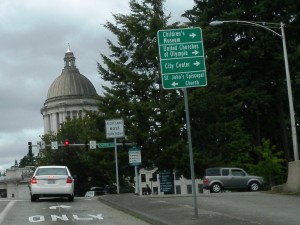 And so you see, I was not prepared for the rooms reserved weeks ago to be refused to me. A chain I often used, this one did not accept cats; my “Pet Friendly” filter somehow slipped. (Big expose some day, about the inconsistencies of chains, and the unkindnesses to pets!) They refused me gently though, and called to find a room for me. A downtown highrise, not my favorite choice, but decision-making time was running short (no water, and no litter box).
And so you see, I was not prepared for the rooms reserved weeks ago to be refused to me. A chain I often used, this one did not accept cats; my “Pet Friendly” filter somehow slipped. (Big expose some day, about the inconsistencies of chains, and the unkindnesses to pets!) They refused me gently though, and called to find a room for me. A downtown highrise, not my favorite choice, but decision-making time was running short (no water, and no litter box).
My reaction was muted by the gray; okay, I’ll take the room. It wasn’t ready yet, please sort it out, I begged. Housekeeper beeped another floor, got somebody on it, quick. “Start your unload,” she soothed, “and bring those kitties in.” She described her long-haired cat, her love of 15 years, “I want to meet your Jack,” she smiled, “and Alex too.” I warmed from blue to pink. Four loads with the rattley cart; four floors on the elevator; and then, we’re home and all is well. Let’s watch the evening news, and catch up with the rest of the world.
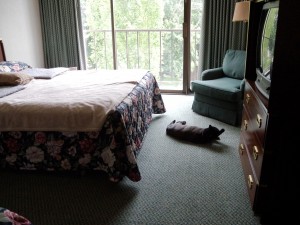 It’s pleasant here. No doubt that things would turn out fine; I’ve got the Bubble over me. Dig through the suitcase for warmer clothes, zip the black sweater clear up to my neck, pull on some socks. It was 109 in Nashville today, the Brian Williams Sunday-substitute is telling on the news, and power’s out all in the stormy east. But I am safe, here at the end of Puget Sound, looking forward to the peace, and quiet, and gentle soothing gray; an easy place to be.
It’s pleasant here. No doubt that things would turn out fine; I’ve got the Bubble over me. Dig through the suitcase for warmer clothes, zip the black sweater clear up to my neck, pull on some socks. It was 109 in Nashville today, the Brian Williams Sunday-substitute is telling on the news, and power’s out all in the stormy east. But I am safe, here at the end of Puget Sound, looking forward to the peace, and quiet, and gentle soothing gray; an easy place to be.

